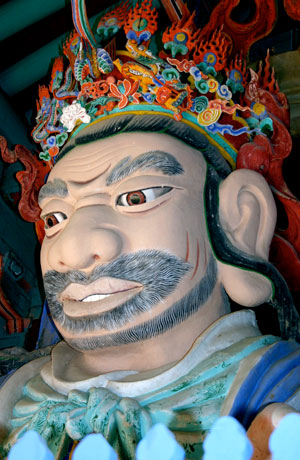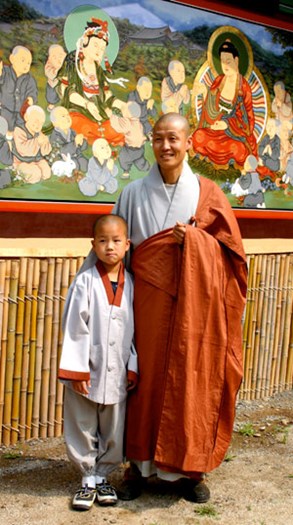SOONCHON CITY, SOUTH KOREA - A gentle knock on a rice paper door signals it’s time for us to begin a journey 1,600 years back in time.
My Korean roommate, a stressed-out businessman named Mr. Pak who speaks only a few words of English, jumps to his feet and eagerly begins folding the bedding we spread on the floor of our simple temple room the night before.
A sore neck and back gained by the experience slows my progress.
“Please, the monk waiting,” Mr. Pak informs me as he opens the door to reveal a star-lit sky.
A glance at my watch tells me it’s only 3:01 a.m.
Days begin early for travelers who sign up to live the life of a monk at one of Korea’s Buddhist temples – something that is becoming more and more popular, according to Gak An, a man dressed in flowing grey and brown robes who greets us with a warm smile as we step into the cool early morning mountain air at Songgwang-Sa Temple.
There are thousands of temples scattered about South Korea – but few are as important as this one. Songgwang-Sa, located in the country’s lush mountainous southwest region, is a national historic site, a place where some of the most important relics of Buddhism and South Korea can be found.
Gak An jokingly informs us, through an interpreter, he is the “PR monk” and will answer all our questions about this temple, built during Korea’s Shilla Dynasty – over 1,600 years ago. But first we must don traditional robes and follow him to the main compound where we join the temple’s 200 monks and some other travellers in early morning prayers.
Little has changed over the past 1,600 years at Songgwang-Sa, according to Gak An – the name he was given 21 years ago when he became a monk.


Left: Korean temples have scary symbols to ward off evil. Right: A monk and his disciple.
“Only the tourists are new,” smiles the clean-shaven 40-something monk as he leads us along a dark path bordered by a rushing stream, whose soothing sound lulled us to sleep only a few hours earlier.
Songgwang-Sa Temple began welcoming tourists in 2000 when South Korea shared the World Cup of soccer with Japan. The country’s hotels could not cope with the influx of extra tourists the mega sports event drew so monasteries like this one were asked to lend a hand. The thought of rowdy British soccer fans in such a serene place sends chills down my spine.
The tourists who did stay here were so impressed they spread the word and the temple was soon inundated with requests from around the world.
“We decided to continue the program because it brings us extra money,” Gak An tells us as we arrive at the entrance to the main temple courtyard, guarded by some fierce-looking mythical statues.
Since the World Cup, thousands of people have booked stays at Songgwang-Sa and a few other temples which offer similar programs. Tourists pay 33,000 won ($45 Cdn.) to live the life of a monk – which involves sleeping in their humble accommodation, eating their plain and simple food, crossing a compound in the middle of the night to go to the toilet and joining them at the main temple three times a day in prayer – the first one starting at this unholy hour. The only thing the monks don’t ask of guests is that they shave their heads.
“You must bow whenever you pass in front of the main temple,” Gak An tells us as we enter the huge courtyard dominated by a main hall filled with handsome golden Buddha statues.
Before the morning prayers begin, Gak An tells us the main activity at the “sunrise ceremony” is the 108 bows monks make “to atone for the 108 sins of mankind” – a Buddist ritual.
We watch as a group of monks parade single file into the main hall while others begin beating a huge drum on a platform on the opposite side of the courtyard. We stand watching until the monks begin ringing a massive bronze bell.
“It is time to enter the main temple,” Gak An informs us.
Korean temples are much more colourful than others I have seen in Asia. The massive wooden structures are decorated with bright red, green and white paint and the interiors glow from the brilliance of the Buddha statues. The monks begin a series of chants and prayers before starting their 108 bows, which, we alarmingly discover, actually involves bowing, kneeling and standing – 108 times.
The athletic-looking monks accomplish their task without working up a sweat. The tourists are having a hard time keeping up. I cheat and stay kneeling several times. A few of the monks look at me like I’ve committed the 109th sin.
The sunrise ceremony lasts about an hour. At the conclusion, we follow Gak An and the other monks to the main eating hall where ample portions of rice, soup and a variety of vegetarian dishes await. The monks’ dishes lack the spicy flavours that highlight traditional Korean cooking but are still tasty and very filling. Gak An warns us that whatever we take, we must finish. You also wash your own dishes here.
“No food is wasted at the temple,” says Gak An.
We are surprised to discover that this order of monks, known as the Chogyes, allows its members to speak during meals.
“Every order is different,” says Gak-An, who looks directly at me and says: “you know this meeting between you and I was determined hundreds of years ago.”
Buddhist believe, he tells me, that most things are predetermined.
The gentle monk, who speaks in low, soft tones, says his monastery offers several different programs for tourists, ranging from day visits to week-long stays.
“The programs are very popular in the summer – we had over 500 people stay last summer,” he says while pouring s some delicious clear tea the monks grow at the temple.
You don’t have to be a Buddhist to experience temple life. In fact, 46 per cent of those who stay have no religious affiliation while 30 per cent are Christian and just a small percentage is Buddist, according to the monk. At the end of their stays, tourists are asked in a survey if they would make a return trip – 89 per cent said they would.
The monks don’t try to convert tourists, although at several points during our stay Gak-An did talk about Buddhism and its philosophy and the man who believes in reincarnation did ask what I thought I was in my last life? He also taught us how to deal with the rigours of modern life by ways of meditation – “feel the wind on your face. Listen to the birds and smell the flowers. Eliminate all other thoughts from your head,” he told us.
Women and men – even husbands and wives – are segregated during their stay at the temple, which sits surrounded by lush, tree covered mountains – a very popular area with hikers.
Gak-An says there are more women than men who sign up for temple stays and that the Korean government is actively promoting tourist stays at monasteries, especially in the domestic market, because “over 80 per cent of the country’s most important historic treasures can be found at temples and monasteries.”
The 3 a.m. prayer is followed by a noontime ceremony and then another at sundown. The noontime event is the most important because, according to the monk, “that is when Buddha would have had his only meal of the day.”
The monks do not watch television but the modern world is creeping into monastery life.
“Some younger monks are teaching me how to use the internet,” says Gak An, who spends much of his day working in the monastery office when he’s not at prayer. Some believers send messages and prayers to the temple over the internet. Most of the monks join the order when they are young men but some do come to it later in life. The Chogye order has implemented an age limit of 40 for those wishing to enter the sect, according to Gak An. One small boy at the monastery, who was dressed in monks gear, was there because his family wanted him to learn more about Buddism, according to our gracious host.
Many young men find they can’t contend with the strict life here and “just run away in the night,” smiled Gak An. Songgwang-Sa Temple is legendary because it has produced 16 great monks – the Buddhist equivilant of popes – and, according to legend, “it will produce two more before the end of its reign,” says Gak An, who just blushes when a visitor suggests he might be one of the remaining two.
I am not the first Canadian to stay at the temple, the monk informs me.
“A Canadian woman who was stressed out from her business life stayed here last year and wrote many nice words about her experience,” says Gak An, who walks with us to the entrance of the temple grounds at the end of our 24-hour stay and wishes us a safe journey home.
While not for the faint of heart, the temple experience does provide a wonderful insight into what life was like 1,600 years ago.
Information
- For information on the Songgwang-Sa temple, go to http://www.songgwangsa.org
- Temple stays include accommodation, food and monks clothing.
- You can get to Soonchon City from Seoul by taking South Korea’s new KTX high-speed train. It’s a two hour trip.
- The temple is located about an hour from Soonchon – a taxi from the main train station at Soonchon costs about $40.
www.templestaykorea.com
- For information on travel to South Korea, go to http://www.tour2korea.com